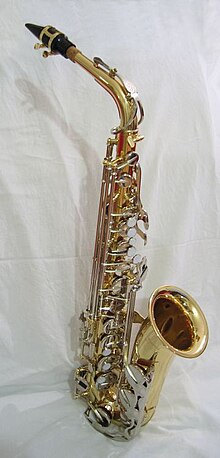Alto saxophone: Difference between revisions
m Reverted 1 edit by Joshua.lefkowitz320 (talk) identified as vandalism to last revision by Special-T. (TW) |
|||
| Line 63: | Line 63: | ||
[[Category:Saxophones]] |
[[Category:Saxophones]] |
||
[[Category:E-flat instruments]] |
[[Category:E-flat instruments]] |
||
Bitch! |
|||
{{DEFAULTSORT:Alto Saxophone}} |
{{DEFAULTSORT:Alto Saxophone}} |
||
Revision as of 10:43, 28 February 2012
 | |
| Woodwind instrument | |
|---|---|
| Classification | Single-reed |
| Hornbostel–Sachs classification | 422.212-71 (Single-reed aerophone with keys) |
| Inventor(s) | Adolphe Sax |
| Developed | 1840s |
| Playing range | |
| In E♭: sounds a major sixth lower than written. Most modern alto saxophones can reach a high F♯ | |
| Related instruments | |
|
Sizes:
Orchestral saxophones: Specialty saxophones: | |
| Musicians | |
| See list of saxophonists | |
The alto saxophone is a member of the saxophone family of woodwind instruments invented by Belgian instrument designer Adolphe Sax in 1841. It is smaller than the tenor but larger than the soprano, and is the type most used in classical compositions. The alto and tenor are the most common types of saxophone.
Transposition
The alto saxophone is an E♭ transposing instrument and reads the treble clef. A written C-natural sounds as the concert E♭ a major sixth lower.
Range
The range of the alto saxophone is from concert D♭3 (the D♭ below middle C—see Scientific pitch notation) to concert A♭5 (or A5 on altos with a high F♯ key). As with most types of saxophones, the standard written range is B♭3 to F6 (or F♯6).[1] Above that, the altissimo register begins at F♯ and extends upwards. The saxophone's altissimo register is more difficult to control than that of other woodwinds and is usually only expected from advanced players.
Alto saxophonists
Notable alto saxophonists include jazz musicians Charlie Parker, Kenny Garrett, Jimmy Dorsey, Johnny Hodges, Art Pepper, Cannonball Adderley, Eric Dolphy, Sonny Stitt, David Sanborn, Ornette Coleman, Anthony Braxton, Jackie McLean, Phil Woods, John Zorn, and Paul Desmond. Classical musicians include Marcel Mule, Sigurd Raschèr, Jean-Yves Fourmeau, Lawrence Gwozdz, Kadri Gopalnath, Donald Sinta, Larry Teal, Jean-Marie Londeix, Kenneth Tse, Arno Bornkamp, Harry White, Otis Murphy, Claude Delangle, and Eugene Rousseau. The alto saxophone is included in classical music more often than the tenor, and many concertos for alto exist. The alto is used commonly in classical, jazz, and marching band music.
Manufacturers
Some companies that currently produce saxophones are Buffet Crampon, KHS/Jupiter, Conn-Selmer, Selmer Paris, Yamaha, Leblanc/Vito, Keilwerth, and Yanagisawa. New alto saxophones range in price between US$200 for lower quality student models to over US$8000 for professional models.
In classical music
The alto saxophone has an extensive classical solo repertoire that includes solos with orchestra, piano, and wind symphony. The most well-known solo compositions are Jacques Ibert's "Concertino da Camera" and Alexander Glazunov's "Concerto in E Flat major".
Also, the alto saxophone is part of the standard instrumentation of concert bands and saxophone quartets.
The alto saxophone is also occasionally used in orchestral compositions. Several of the major orchestral examples are listed below.
Georges Bizet features it in the Minuet from the second suite of music from L'Arlésienne.
It was called for by Richard Strauss in his Sinfonia Domestica, which includes parts for four saxophones including an alto saxophone in F.
Dmitri Shostakovich uses the alto in his Suite for Variety Orchestra and it has a prominent solo in the Waltz No. 2 section. He also includes it in his Suite No. 1 and Suite No. 2.
Maurice Ravel uses the saxophone prominently in his orchestration of Modest Moussorgsky's Pictures at an Exhibition, most notably as the soloist in "Il Vecchio Castello".
Alban Berg uses the saxophone in his late orchestral works, most notably Der Wein, Lulu, and the Violin Concerto.
Sergei Rachmaninoff uses the saxophone in his Symphonic Dances as a soloist in the first movement.
George Gershwin includes it in a few pieces; such as Rhapsody in Blue and An American in Paris.
Gallery of Alto Saxophones
-
Vintage silver-plated 'Pennsylvania Special' alto saxophone, manufactured by J.Keilwerth[2] in Czechoslovakia, circa 1930
-
Conn 6M "Lady Face" brass alto (dated 1935) in its original case
-
Conn 'Pan American' alto, manufactured circa 1948. Has similar body to a Conn 6M and keywork which is reminiscent of a Conn New Wonder Series 1 and 2
-
Grafton alto made of plastic, circa 1950s
-
Yamaha YAS-25 alto saxophone, circa 1990s
-
Yanagisawa A9932J alto saxophone: has a solid silver bell and neck with solid phosphor bronze body. Manufactured in 2008
References
- ^ "Range of the Alto Saxophone". Library.thinkquest.org. Retrieved 2011-01-18.
- ^ Photo Gallery :: SaxPics.com
Bitch!


![Vintage silver-plated 'Pennsylvania Special' alto saxophone, manufactured by J.Keilwerth[2] in Czechoslovakia, circa 1930](http://upload.wikimedia.org/wikipedia/commons/thumb/0/08/KeilwerthAltoSax.JPG/64px-KeilwerthAltoSax.JPG)




